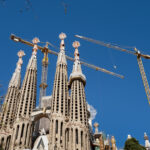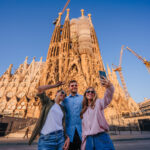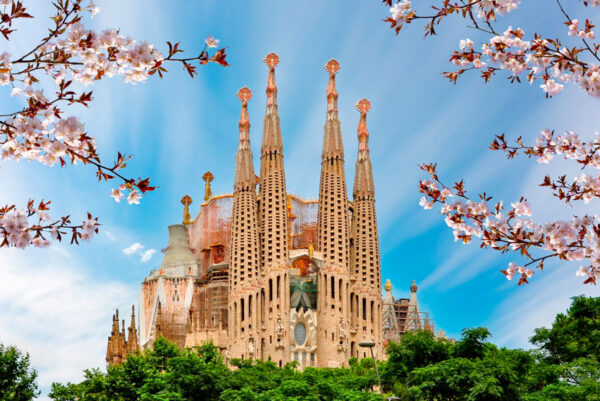
- Captivating Architectural Details of Sagrada Familia: A Deep Dive
- The History of Sagrada Familia: Barcelona's Iconic Landmark
- Exploring the Symbolism Behind Sagrada Familia's Design
- Photography Tips for Capturing the Beauty of Sagrada Familia
- Sagrada Familia: A Must-See Attraction in Barcelona
- Visiting Sagrada Familia: What You Need to Know
The Sagrada Familia, a masterpiece of architectural genius designed by Antoni Gaudí, stands as a testament to the rich artistic heritage of Barcelona. Its intricate facades and towering spires capture the imagination of visitors from around the world, making it a must-see landmark in Spain.
In this article, we explore Captivating Images of Sagrada Familia: Barcelona's Iconic Landmark in Spain, showcasing the stunning details and unique features that make this basilica an enduring symbol of creativity and devotion. Join us as we delve into the beauty that continues to inspire countless photographers and admirers alike.
Captivating Architectural Details of Sagrada Familia: A Deep Dive
The architectural brilliance of the Sagrada Familia lies in its meticulous attention to detail. From the ornate carvings of biblical figures to the organic shapes that mimic natural forms, every element tells a story. Gaudí's vision was to create a structure that harmonizes with its surroundings, and this is evident in the way the light filters through the stained glass, casting colorful patterns on the interior walls.
One of the most captivating aspects of the basilica is its facade design. The Nativity Facade, for example, showcases a rich tapestry of sculptures, including animals and plants, that reflect Gaudí's deep connection to nature. In contrast, the Passion Facade presents a stark, angular style that conveys the emotional intensity of Christ's crucifixion. This interplay between the two facades highlights Gaudí's innovative approach to architectural storytelling.
Inside the basilica, visitors are greeted by towering columns that resemble tree trunks, creating a forest-like atmosphere. This naturalistic approach extends to the vaulted ceilings, which are designed to mimic the branching of trees. The overall effect is one of awe and tranquility, inviting contemplation and appreciation of both the divine and the artistry involved in its construction.
To further explore the architectural details, consider the following key features:
- Spiral Towers: Reaching heights of up to 170 meters, these towers symbolize the aspirations of humanity towards the heavens.
- Hyperboloid Structures: Utilizing hyperboloid geometry, Gaudí created a dynamic visual effect that enhances the basilica's overall aesthetic.
- Natural Light: The integration of stained glass windows not only beautifies the space but also plays a significant role in the building's spiritual ambiance.
The History of Sagrada Familia: Barcelona's Iconic Landmark
The history of the Sagrada Familia is as fascinating as its design. Construction began in 1882, led by architect Francisco de Paula del Villar. However, it was not until Antoni Gaudí took over in 1883 that the project truly began to reflect its distinctive style. Gaudí dedicated more than 40 years of his life to the basilica, transforming it into a lifelong masterpiece that embodies his unique vision.
Throughout its construction, the Sagrada Familia has faced numerous challenges, including funding issues and political turmoil. Despite these obstacles, the dedication to Gaudí's vision has allowed the basilica to continue developing over the years. Today, it is recognized as a UNESCO World Heritage Site, celebrating its architectural significance and cultural importance.
The basilica is not only a religious site but also a symbol of Barcelona's resilience and creativity. Construction is ongoing, with an anticipated completion date in the next decade. The collaborative efforts of various architects and artisans who have worked on the project have ensured that Gaudí’s original intentions remain at the forefront as they adapt to modern techniques.
Key milestones in the history of the Sagrada Familia include:
- 1882: Groundbreaking ceremony and initial construction begins.
- 1914: Gaudí's death; only a quarter of the project completed.
- 2010: Gaudí's Sagrada Familia is consecrated as a basilica by Pope Benedict XVI.
- 2026: Anticipated completion of the basilica, marking the centenary of Gaudí's passing.
Exploring the Symbolism Behind Sagrada Familia's Design
The Sagrada Familia is not just an architectural wonder; it is a profound expression of faith and spirituality. Gaudí infused the design with rich symbolism meant to convey biblical narratives and divine concepts. This intentionality is evident in the way various architectural elements relate to religious themes, inviting visitors to reflect on deeper meanings embedded in the structure.
Key symbolic aspects of the Sagrada Familia's design include:
- The Three Facades: Each facade represents a different aspect of Christ's life: the Nativity, the Passion, and the Glory, encapsulating the journey from birth to resurrection.
- Nature Inspirations: Gaudí's use of organic forms and natural motifs reflects his belief that nature is a manifestation of the divine, symbolizing harmony between humanity and creation.
- The Columns: Resembling trees, the columns not only provide structural support but also symbolize strength and life, creating a sacred forest within the basilica.
Furthermore, the intricate details within the Sagrada Familia serve as visual parables. For example, the use of geometric shapes is not merely aesthetic; they represent the mathematical order of the universe, illustrating the connection between faith and reason. This innovative approach to structural design transforms each visit into a contemplative experience.
In summary, the Sagrada Familia is a complex tapestry of faith, nature, and architectural mastery. Each design element is laden with meaning, encouraging visitors to explore the deeper connections between art, spirituality, and the natural world. This embodiment of Gaudí's vision continues to inspire awe and reverence, making it a landmark not only in Barcelona but in the realm of religious architecture.
Photography Tips for Capturing the Beauty of Sagrada Familia
When photographing the Sagrada Familia, consider the time of day to capture the best light. Early morning or late afternoon provides soft, warm tones that enhance the architectural details and colors of the stained glass. Moreover, the golden hour adds a magical glow that can turn your images into stunning works of art.
Utilizing different angles can significantly impact your photography. Experiment with perspectives by shooting from the ground up to emphasize the towering spires, or find elevated spots that offer a panoramic view of the basilica. Don't hesitate to include elements of the surrounding landscape, such as trees or nearby buildings, to provide context and depth to your shots.
Another crucial tip is to pay attention to the details. The intricate carvings and textures are what make the Sagrada Familia unique. Use a zoom lens to capture these elements up close, or try a macro lens for an even more intimate look at the craftsmanship. This approach can reveal aspects of Gaudí’s vision that might go unnoticed from a distance.
Finally, consider incorporating people into your photos to convey scale and the vibrant atmosphere surrounding the landmark. Capture candid moments as visitors admire the basilica or interact with its features. This not only adds a human element to your photography but also showcases the cultural significance of this iconic landmark.
Sagrada Familia: A Must-See Attraction in Barcelona
Visiting the Sagrada Familia is an unforgettable experience that resonates deeply with both tourists and locals alike. As one of the most iconic landmarks in Spain, it draws millions of visitors each year, eager to witness Gaudí's unparalleled vision. The basilica’s unique combination of Gothic and Art Nouveau styles creates a stunning visual spectacle that captivates the eye and ignites the imagination.
What sets the Sagrada Familia apart is not only its grand scale but also the intricate details that adorn its structure. Each facade tells a story, adorned with sculptures representing various biblical figures and themes. The immersive experience of entering this architectural wonder invites visitors to explore its depths, where every corner reveals new artistic marvels, making it a must-see attraction in Barcelona.
Beyond its architectural brilliance, the Sagrada Familia serves as a spiritual haven for many. The basilica's design is infused with symbolism that reflects Gaudí’s deep faith and connection to nature. This synergy between artistry and spirituality creates a serene environment, allowing visitors to reflect and connect with the essence of the place, enhancing its status as a pilgrimage destination.
Furthermore, accessibility to the site has improved over the years, ensuring that everyone can appreciate its beauty. A variety of guided tours and resources are available, which help visitors understand the significance of the basilica’s features. With its ongoing construction, the Sagrada Familia not only represents the past but also embodies a vision for the future, solidifying its place as an essential part of Barcelona’s cultural heritage.
Visiting Sagrada Familia: What You Need to Know
When planning your visit to the Sagrada Familia, it is essential to consider timing and ticket options. The basilica can get quite crowded, especially during peak tourist seasons. To make the most of your experience, consider booking your tickets online in advance. This not only saves time but also guarantees your entry on the preferred date and time. Additionally, early morning or late afternoon visits provide a more serene atmosphere, allowing for deeper reflection on Gaudí's masterpiece.
While exploring the Sagrada Familia, take advantage of the numerous guided tours available. These tours offer valuable insights into the basilica's history and architectural significance. You can choose from various options, including audio guides, small group tours, or private experiences. Each type enhances your understanding of the intricate details and symbolism woven into the structure. Here are some options to consider:
- Audio Guides: Ideal for solo travelers who prefer to explore at their own pace.
- Small Group Tours: Offers a more personalized experience with an expert guide.
- Private Tours: Perfect for those seeking an in-depth exploration tailored to specific interests.
Another crucial aspect to remember is the dress code. As the Sagrada Familia is a religious site, visitors are expected to dress appropriately. Ensure to wear modest clothing that covers shoulders and knees, as this demonstrates respect for the sacred environment. Additionally, comfortable footwear is recommended, as exploring the basilica involves walking through various levels and staircases.
Lastly, be prepared to be mesmerized by the stunning interior. The use of light and color through the stained glass windows creates a breathtaking atmosphere that changes throughout the day. Allow yourself ample time to wander and take in the beauty of the basilica. Remember to bring your camera to capture the enchanting details, but also take moments to appreciate the spirituality and artistry surrounding you. The Sagrada Familia promises an unforgettable visit that transcends mere sightseeing.
 La Sagrada Familia de Barcelona: aún en construcción
La Sagrada Familia de Barcelona: aún en construcción Sagrada Familia Fast-Track Ticket: Skip the Lines!
Sagrada Familia Fast-Track Ticket: Skip the Lines! The Ultimate Barcelona Experience: Sagrada Familia Tour
The Ultimate Barcelona Experience: Sagrada Familia TourIf you want to know other articles similar to Captivating Images of Sagrada Familia: Barcelona's Iconic Landmark in Spain you can visit the category WHERE YOU CAN GO.
Deja una respuesta










Read more!